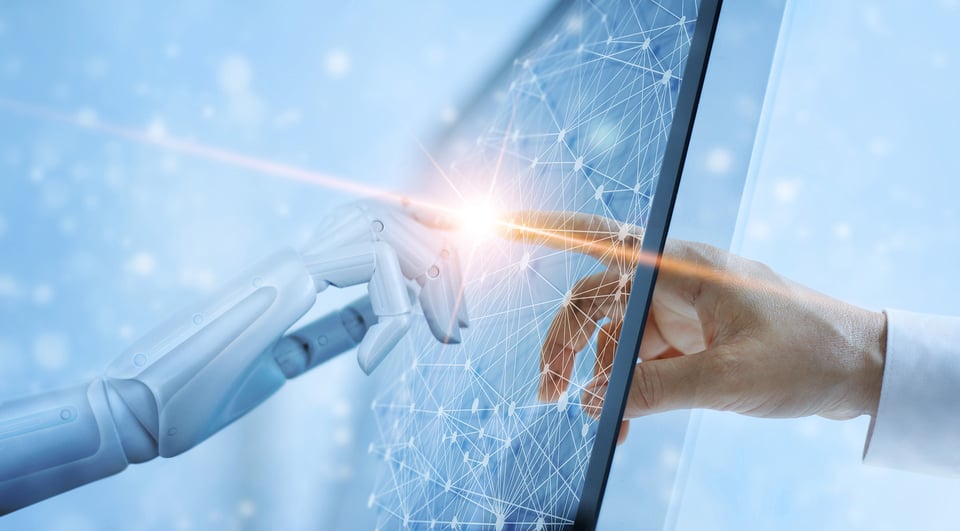by Hassan Faouaz –
It seems that Artificial Intelligence is on everyone’s mind nowadays. People are talking about how AI is going to change the world. But many are thinking of AI as a potential enemy of humanity, like ‘SkyNet’ from Terminator. Many believe that AI will become so smart and self-aware that it will begin overriding networked systems, destroying societies, and will ultimately take over the world.
Well, I had that same perception when I was 8 years old. But as I grew, so did my understanding of AI. And my perception of Artificial Intelligence has changed. I know now that AI offers much potential for improving our lives, and for helping each of us, as individuals, focus on the more important things in life.
AI’s Positive Impact Has Already Begun
We won’t have to wait for the distant future to experience AI’s positive benefits. Most of us experience some of those benefits right now, every day. Let’s consider an example of something that has become a first-thing-in-the-morning routine for most of us: We wake in the morning, open our cell phones, and go through our emails.
Simple enough.
But then after we clear out our inbox, we might notice that our ‘Spam’ folder is loaded with dozens of messages. And we think, “What a relief. I am glad my mail provider is sorting all of that spam from my inbox. I don’t have time to waste deleting emails from a Nigerian prince, or about the next big can’t-miss stock, or about how I can win a free vacation!” Instead, we can focus our time on important emails.
That nice little service that your mail provider performs for you of sorting out the spam? That’s Artificial Intelligence — the very same AI that some believe will destroy humanity. To be specific, it is a classification algorithm that is sorting your email. And when you look at an email that’s been placed in your spam folder and you identify it as a legitimate message, the algorithm will learn, and classify a similar email correctly on the next run.
“Wow! You mean AI is sniffing my email? Is that illegal? An invasion of privacy?” Is that what you’re thinking? This is where I started to dive into AI and Machine Learning, trying to understand how this feature works.
I realized that the data used to teach the machine is not only my data, but millions upon millions of emails that the mail provider is using to teach the machine how to classify and sort emails. And I learned that the machine is not reading every email and trying to make sense of each message. It’s not concerned about whether I am about to buy a new house, planning to visit my relatives or about to go on vacation.
So if the machine isn’t reading your messages and burrowing into all the private details of your life, then how IS the machine learning to classify your emails?
The machine — or, more correctly, a snippet of computer code — is running through the emails and trying to decipher the perfect pattern for a spam email. This pattern could be built upon a variety of factors, such as:
- Certain subject line keywords that could flag a spam message
- A rash of misspelled words in the message
- Many occurrences of incorrect grammar
Many factors go into building that pattern. But most importantly, that pattern is made stronger and smarter each time you swipe an email and identify it as spam. This little gesture goes back to the email provider and is fed into the data set. And then every email user will benefit when they receive that particular “Buy this stock, it will go up by 10,000% in 2 years” spam email.
I have simplified the process to a degree, but you get the point: Your email spam filter is an example of how AI makes our life just a little better and more productive by helping us focus on the emails that deserve our attention.
AI Might Save Your Life — Not in the Distant Future, But Today
Now that I’ve finished my morning email routing, I move on to the next phase of my day: driving to work. I jump in my car, head to work and while on the highway, I enable my ‘smart cruise control’ — a new feature that I bought (the sales person told me it would change my daily commute).
So, as I am driving, with just a click of a button my car is now cruising comfortably at 50 MPH. But here’s the impressive part: If I drift out of my lane from distraction or drowsiness, the steering wheel vibrates and an alarm sounds. Then, of course, I steer the car back into my lane (maybe I shouldn’t have been checking my texts!).
What happened here? The car may have saved my life by preventing me from drifting into another car or the ditch. Is this another example of Machine Learning? Indeed so. The car is equipped with cameras, sensors, and GPS, and — again, through a bit of computer code — all this data is fed into the algorithm, making it ‘aware’ of the position of the car relative to those painted lines on the road. The machine was trained to identify white lines, yellow lines, and solid lines, and these different classifications helps the algorithm detect the lanes and develop ‘awareness’ of whether the car is going to cross them without the driver signaling or turning the steering wheel.
This is another Machine Learning feature that eventually will become commonplace and is likely to vastly reduce accidents simply by alerting the driver when the car strays.
When Did I Fall in Love with Machines That Can Learn?
My love story began when I first started developing Machine Learning solutions. I soon realized that AI holds endless potential for making our lives better — one little problem at a time.
One example I’ve been involved with is projects designed to collect data to help financial institutions with early fraud detection and prevention using Machine Learning. Why Machine Learning for this purpose? Because the pattern of the transactions is so complex that only a machine can detect it. It is simply beyond the capacity of humans to process this mass of data with the speed and accuracy necessary to consistently flag indications of fraud. Through this project, I realized that Machine Learning is just a facilitator to our lives.
If the Machine can help me in detecting a problem faster and averting a disastrous outcome, why not use it? After all, the Machine only learns what we are teaching it. It’s not smart enough to learn everything; it requires our guidance in identifying what it needs to learn to achieve the desired output.
AI is currently helping doctors and scientists in identifying cells in the body that may be damaged before those cells can cause irreparable damage to the body. AI is helping police to identify the areas in cities that are most likely to suffer high crime rates. AI is helping security cameras to identify and prevent crimes.
For all the above reasons, I fell in love with the Machine. Because, in the end, the Machine is simply another tool to make our lives better. Or, to put it differently: The purpose of AI-enabled machines is to help us, not replace us.
The concept of AI battling humanity for control of the planet might make for great fiction. But the reality is considerably more pleasant — and already underway.
To Learn more:
Subscribe to receive more blogs like this from RCG
#IdeasRealized




